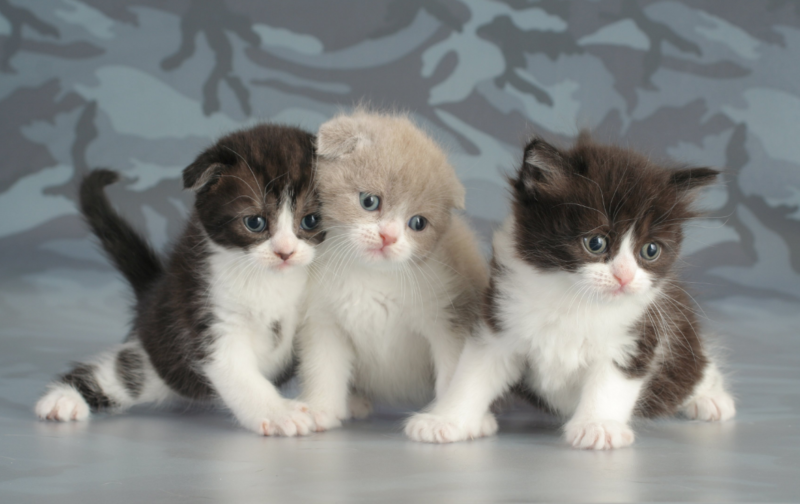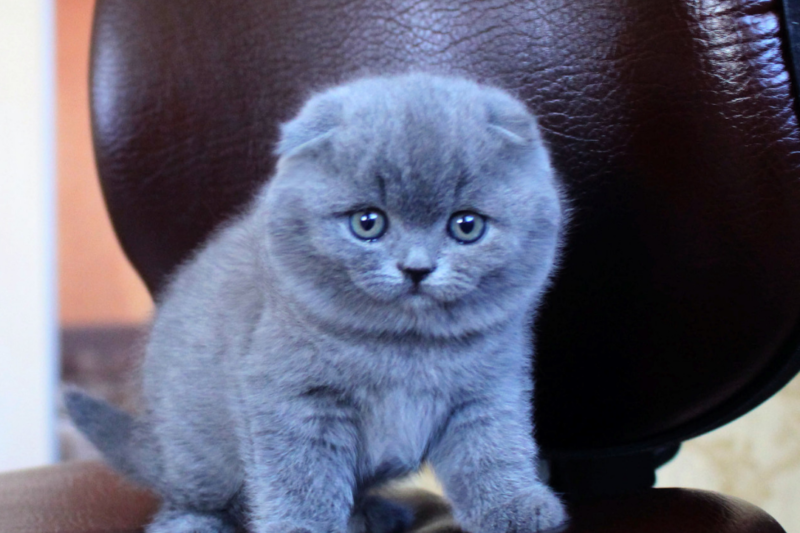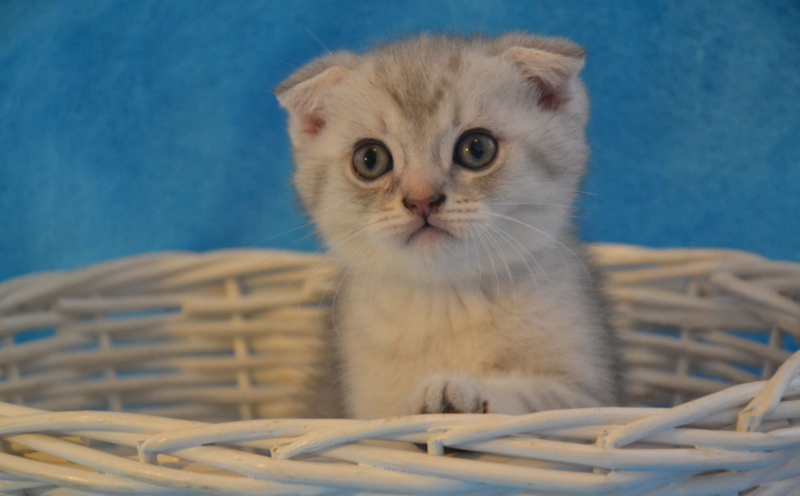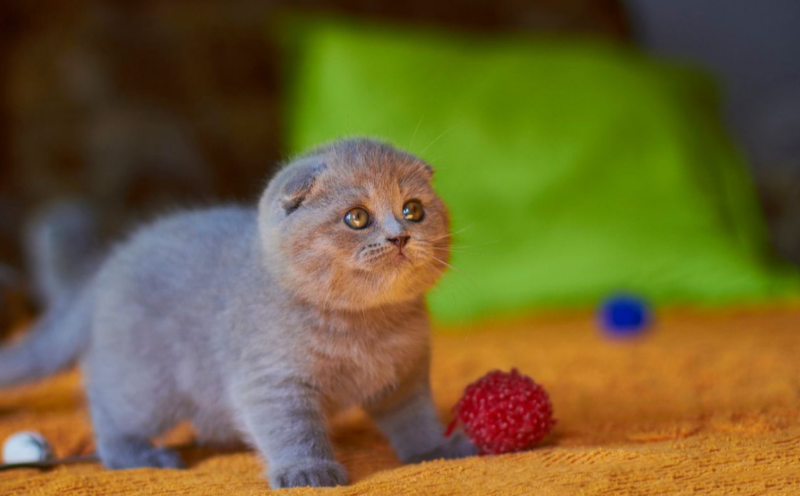Scottish fold kittens or Scottish folds are the most unusual representatives of the cat family. Pretty rounded muzzles and gullible large eyes immediately cause sympathy.
Material Content:
Breed description
Characteristic features of the breed representatives are ears bent forward to the head and a short wide nose. The coat can be thick, with good undercoat or silky, half-length.
Colors of Scottish Folds:
- the black;
- cream;
- blue;
- spotted;
- marble;
- bathtubs (white with small marks of a different color);
- tortoiseshell (black with inclusions of white and red);
- white;
- brown;
- ginger;
- smoky;
- tabby
- harlequin (white with colored spots, occupying no more than 20% of the color);
- bicolor.
The breed is notable for its “silence” and a quiet, slightly creaky voice. It is moderately muscular animals, with rounded body shapes. They resemble the British breed, but not so stocky, lighter, with a moderately wide chest and medium-length limbs. In healthy cats, the tail is long, mobile.
Origin history
The history of the breed has a little more than 50 years. Scottish fold appeared as a result of a spontaneous mutation. A Scottish farmer discovered a snowy cat Susie with bent ears. Thanks to happily prevailing circumstances and efforts of breeders, a new breed appeared.
Scottish fold breeding work began in 1963. Susie's descendants were crossed with British cats, trying to maintain the main feature - ears pressed to the head.
This feature turned out to be a consequence of genetic changes; it was not inherited by all kittens in the litter.In addition to the British breed, American exotics and Persian cats participated in the breeding.
But after 10 years, English breeders suspended work on breeding. It turned out that when two individuals with hanging ears were crossed, offspring with serious problems in the development of the musculoskeletal system was born. Many kittens were not viable, and died in terrible torment.
Since 1971, American specialists have perfected the breed. Scientists of genetics have found that in order for healthy kittens to be born, it is necessary to cross lop-eared producers with erect. The new breed began to gain popularity and was soon registered by American felinological organizations. Longhaired representatives of the species were recognized only in 1980.
Breed characteristics
When reading the description of the nature of Scottish folds, many owners disagree with its truth. Indeed, a lot depends on what kind of care for a Scottish fold kitten is carried out after birth. A special role is played by heredity; you cannot buy an animal from a breeder without meeting the parents of the litter.
A successful representative of the breed, which inherited a healthy nervous system, is distinguished by good nature and sociability. He is loyal to the master and follows him everywhere. It is distinguished by delicacy, never requires excessive attention to itself. It gets along well with other animals, living with them in a small area. Most often, he chooses a “pet” for himself in the family, to whom he pays more attention, comes to play and enjoy. Adult animals are a bit lazy, like to sleep in a cozy corner most of the day, and small kittens are very mobile, they are ready to constantly frolic until they are completely exhausted.
The advantages of the breed include quick wit and cleanliness. Accustomed from childhood to a claw-brush and a tray, animals never spoil furniture and do not spoil the apartment. They do not bother with constant meowing, they can only give a voice when they are hungry. Cats do not suffer from excessive shyness, calmly tolerate a trip in public transport, if you put them in a special carrying.
Standard how to choose a kitten
It is useful to familiarize yourself with the requirements of the standard before choosing a kitten if you want to participate in exhibitions or engage in breeding. Knowing the characteristics of the breed, it is easier not to make a mistake in choosing a future pet. The established parameters are common to all representatives of this species; unacceptable defects in the appearance or nature of the animal are taken into account.
Description of the breed:
- individuals of medium size weighing from 3 to 6 kg;
- the head is round;
- ears wide apart, hanging or tightly pressed to the head;
- eyes are large, round, correspond to coat color;
- body slightly elongated, distinguished by grace;
- the same width of the shoulders and hips;
- limbs of medium length and thickness, with small rounded paws;
- wide chest;
- the tail is medium or long.
The disadvantage is a fixed tail and thickened hind legs that interfere with normal walking. There are many colors of wool, common and popular are blue and silver.
When choosing a kitten, it is advisable to pay attention not only to his appearance. The lop-eared gene can cause some congenital diseases - arthritis, osteochondrodysplasia, arthrosis, chondrostrophy. Problems most often arise with improper crossbreeding.
When buying from a breeder, you need to ask when the kittens were vaccinated, whether the pedigree and the medical documents of the parents are in order.
See where the kids are kept, played and eat. To choose a pet with characteristic ears pressed to the head, you need to look at the number of folds. If there are three on the auricles - such a fold kitten is considered the most valuable, its small ears are well pressed to the head.This sign is finally formed at the 6th week of life, so it makes no sense to choose a future pet earlier.
Care, Feeding and Maintenance
The short-haired Scottish fold cat is very easy to care for. You can bathe it once every 2 months, sometimes comb it, removing dead hairs. It is advisable to comb the long-haired fold with the help of a furminator so as not to collect shedding wool on carpets and sofas.
An important part of cat hygiene is caring for your eyes, ears and teeth. The big, wide-open eyes of the folds can become inflamed if they are not wiped daily with a cotton swab dipped in clean boiled water. The ears are wiped with cotton soaked in the intended lotion once a week. Teeth are cleaned with a special paste from the pet store once every 2-3 days.
The cat should have its own corner where she can retire and relax. The place of a comfortable stay can be an open / closed couch, or a house.
Those who breed or keep several cats together buy a multi-level game complex where animals can run, climb, jump and hide for their pleasure. A kitten needs toys - balls made of various materials: rubber, plastic, wood, fabric. For joint entertainment, you can buy clockwork mice, long sticks with feathers and other fun items in the pet store.
Feeding Scottish fold has no special differences. As with other cat breeds, finished industrial feeds or natural foods can be included in the diet. Kittens up to 8 months old need 4 meals a day, then you can switch to 2 meals a day. The water in the bowl should be constant. For a day, it is permissible to freely leave dry food for Scottish fold kittens, if no one is at home. Of the finished formulations, it is advisable to buy those that contain more meat, fewer grain fillers and flavors. Breeders advise buying superfood class feeds hermetically packed, and never take them by weight.
Parenting
Cats are not accepted to train, but this does not mean that they are stupider than dogs. Scottish fold perfectly understand the commands and prohibitions. The permissible framework should be set for the kitten as soon as he gets into the house, and try not to break them.
If you do not want your pet to beg for food when you eat, never feed him from your table. Do not like to sleep with a cat on her head, do not let her climb into a spread bed. When there is no desire to contemplate her tail next to the computer monitor, do not allow to climb onto the desktop.
The framework of prohibitions must be fair, unchanged and understandable to the animal. Allow at least once to do what you always forbid, do not rely on obedience. If the cat spoils the furniture and wallpaper with its claws, not wanting to approach the claw point, you need to be patient and accustom yourself to the order gradually. You won’t achieve anything with shouts and punishments. Cats are very smart and always appreciate the respectful and kind attitude of the owner.
Scottish fold kittens and children
Many breeders claim that Scottish fold cats are genetically devoid of aggression and children and older people may be their best friends. This statement is only partly true. An important role is played by the upbringing of the kitten and the good attitude of the child to it.
Scottish folds are indeed more seasoned and patient than representatives of native breeds - Maine Coons, Angora, Siberian and Norwegian forest cats.
But the nature of the animal markedly expressed freedom of love, they are independent, and will not allow themselves to offend.
In case of childhood terror, folds can easily give a painful rebuff using sharp teeth, claws and strong hind legs. Attitude to a person will correspond to the degree of respect for his feline needs and weaknesses.If the child is old enough to understand and not violate the rules of behavior in communicating with a pet, there will be no conflicts and tears at home. Scottish fold kittens are very playful and agile. Who else can keep a good company with a restless fluffy ball, if not a child? Of course, all responsibility for caring for the animals rests with the parents.
Pros and cons of the breed
Scottish fold have many undeniable advantages:
- good looks;
- high intelligence;
- affection for the owner and his family;
- good nature and playfulness.
The nature of the cat - sociable and unobtrusive - like many owners. The disadvantages include the fact that the breed is difficult to breed. To get a healthy kitten with hanging ears, you need to cross an erect animal with a fold.
Buying a Scottish fold kitten is a crucial step, because this fluffy miracle will become a full member of the family for the next decade. Therefore, you need to choose and raise a pet deliberately.



















